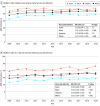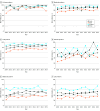Racial and Ethnic Disparities in Mother's Milk Provision Among Mothers of Preterm Infants
- PMID: 40377941
- PMCID: PMC12084848
- DOI: 10.1001/jamanetworkopen.2025.10781
Racial and Ethnic Disparities in Mother's Milk Provision Among Mothers of Preterm Infants
Abstract
Importance: The extent of mother's milk provision by race and ethnicity and its change over time is poorly understood in the US preterm population.
Objective: To examine US prevalence and trends over time of mother's milk initiation and continuation at 12 weeks after birth (2009-2019) by maternal race and ethnicity and to examine associations of maternal race and ethnicity and mother's milk initiation and continuation among mothers of preterm infants.
Design, setting, and participants: This cross-sectional study used data from the nationally representative Pregnancy Risk Assessment Monitoring System database. Participants included mothers of preterm infants identifying as non-Hispanic Asian, non-Hispanic Black, Hispanic any race, or non-Hispanic White, with survey completion 12 or more weeks post partum from 2009 to 2019. Data were analyzed from February 2022 to June 2024.
Exposure: Maternal race and ethnicity obtained from birth certificate data.
Main outcomes and measures: Mother's milk initiation and continuation at 12 weeks were assessed using survey questions. The overall prevalence and trends over time by maternal race and ethnicity were determined. Multivariable regression was used to analyze independent associations between maternal race and ethnicity and mother's milk initiation and continuation.
Results: Among 1 523 131 (weighted) mother-preterm infant dyads, mother's milk initiation increased significantly from 2009 to 2019 for White and Black mothers but not for Asian or Hispanic mothers. Mother's milk provision at 12 weeks increased significantly among all groups. There were significant differences in mother's milk outcomes between groups. Initiation was highest for Asian mothers (92.8%; 95% CI, 91.1%-94.4%), followed by Hispanic (88.1%; 95% CI, 86.5%-89.8%), White (84.1%; 95% CI, 83.3%-84.9%), and Black (75.3%; 95% CI, 73.4%-76.6%) mothers. After adjusting for covariates of interest, compared with White mothers, initiation remained higher for Asian (adjusted relative risk [aRR], 1.09; 95% CI, 1.06-1.12) and Hispanic (aRR, 1.10; 95% CI, 1.08-1.12) mothers. Continuation at 12 weeks was highest for Asian mothers (65.4%; 95% CI, 62.7%-68.0%), followed by Hispanic (48.2%; 95% CI, 46.1%-50.3%), White (47.7%; 95% CI, 46.7%-48.7%), and Black (34.3%; 95% CI, 32.9%-35.7%) mothers. After adjustment, continuation was higher for Asian (aRR, 1.37; 95% CI, 1.24-1.47) and Hispanic (aRR, 1.33; 95% CI, 1.27-1.41) mothers compared with White mothers.
Conclusions and relevance: In this cross-sectional study, mother's milk provision among preterm infants increased from 2009 to 2019, but notable racial and ethnic disparities persist. Future work should address barriers to continued provision of mother's milk for preterm infants.
Conflict of interest statement
Figures



Similar articles
-
Mother's Own Milk Provision During the First 12 Weeks of Life by Gestational Age.JAMA Netw Open. 2025 Mar 3;8(3):e250024. doi: 10.1001/jamanetworkopen.2025.0024. JAMA Netw Open. 2025. PMID: 40042846 Free PMC article.
-
Racial/ethnic disparities in costs, length of stay, and severity of severe maternal morbidity.Am J Obstet Gynecol MFM. 2023 May;5(5):100917. doi: 10.1016/j.ajogmf.2023.100917. Epub 2023 Mar 5. Am J Obstet Gynecol MFM. 2023. PMID: 36882126 Free PMC article.
-
Racial and ethnic disparities in fecundability: a North American preconception cohort study.Hum Reprod. 2025 Jun 1;40(6):1183-1194. doi: 10.1093/humrep/deaf067. Hum Reprod. 2025. PMID: 40246287
-
Racial and Ethnic Minorities Underrepresented in Pain Management Guidelines for Total Joint Arthroplasty: A Meta-analysis.Clin Orthop Relat Res. 2024 Sep 1;482(9):1698-1706. doi: 10.1097/CORR.0000000000003026. Epub 2024 Mar 18. Clin Orthop Relat Res. 2024. PMID: 38497759
-
Early skin-to-skin contact for mothers and their healthy newborn infants.Cochrane Database Syst Rev. 2016 Nov 25;11(11):CD003519. doi: 10.1002/14651858.CD003519.pub4. Cochrane Database Syst Rev. 2016. PMID: 27885658 Free PMC article.
References
-
- March of Dimes . Preterm birth overview: PeriStats. Accessed December 17, 2023. https://www.marchofdimes.org/peristats/data?top=3

